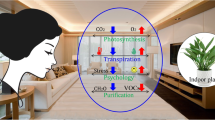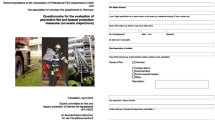Abstract
Thirty homes of asthmatic adults located in Mexico City were examined to determine the predominant culturable fungi and the changes in their airborne concentrations. Fungi were cultured and identified microscopically from air samples collected in naturally ventilated homes, during both wet (July–August) and cool dry (November–December) seasons, and from settled dust from the same homes. Airborne dust from indoor yielded 99–4950 cfu m−3, and settled dust 102–106 cfu g−1 on DG18 agar. The indoor geometric mean concentration of airborne fungi during the cool dry season was 460 cfu m−3 while in the wet season it was 141 cfu m−3. Similarly, numbers of airborne fungal propagules out of doors decreased 60% between the dry and wet season. In general, the total fungal concentrations in indoor air were less than 103 cfu m−3 and a large proportion of them was collected in Stage-2 of the Andersen sampler. Moreover, the ratio between indoor and outdoor concentrations was <3:1. Five of the 30 sampled homes yielded >500 cfu m−3 of one genus, with up to 1493Cladosporium cfu m−3 or 2549Penicillium cfu m−3. Also, these two genera were predominant in both airborne and settled dust, and their concentrations were greater indoors than out, indicating a possible indoor source of fungal propagules. The predominant species wereCladosporium herbarum, Penicillium aurantiogriseum andP. chrysogenum. These results suggest that exposure to large concentrations of fungi occurs indoors and is associated with both seasons of the year and with particular home characteristics.
Similar content being viewed by others
References
Abdalla, M.H. (1988) Prevalence of airborneAspergillus flavus in Khartoum (Sudan) airspora with reference to dusty weather and inoculum survival in simulated summer conditions. Mycopathology 104, 137.
American Public Health Association. (1985) Standard methods for the examination of water and wastewater, 16th. ed. Washington, DC, American Public Health Association.
Becker, R. (1994) Fungal disfigurements of construction analysis of the effects of various factors. In: R.A. Samson, B. Flannigan, M.E. Flannigan, A.P. Verhoeff, O.C.G. Adan and E.S. Hoekstra (Eds.), Health Implications of Fungi in Indoor Environments. Amsterdam, Elsevier, pp. 361–380.
Beguin, H. (1995) Mould biodiversity in homes II. Analysis of mattress dust. Aerobiologia 11, 3–10.
Bronfman, M., Guiscafre, H., Castro, V., Castro, R. and Gutiérrez, G. (1988) II. La medicina de la desigualdad: una estrategia metodológica, análisis de las caracteristicas socioeconómicas de la muestra. Arch. Invest. Méd. (México) 19, 351–360.
Bunnag, C., Dhorranintra, B. and Plangpatanapanichya, A. (1982) A comparative study of the incidence of indoor and outdoor mold spore in Bangkok, Thailand. Ann. Allergy 48, 333–339.
Burge, H.A. (1990) The future, biological contaminants in indoor environments, ASTM STP 1071. In: P.R. Morey, J.C. Feeley and J.A. Otten (Eds.), Philadelphia, American Society for Testing and Materials, pp. 215–220.
Cueva, V.J. and Téllez, G. (1958) Hongos del interior de la habitación de la Ciudad de México. Alergia 6, 243.
Ebner, M.R. and Haselwandter, K. (1992) Indoor and outdoor incidence of airborne fungal allergens at low and high-altitude alpine environments. Mycol. Res. 96, 117–124.
Enríquez, P.O. (1995) Aeroalergenos, pruebas cutáneas y enfermedad alérgica en 1091 pacientes. Tesis de Posgrado. Fac. Medicina, UNAM, México, D.F., 25 p.
Escamilla, G.B., Comtois, P. and Cortés, B.P. (1995) Fungal content of air samples from some asthmatic childrens’ homes in Mexico City. Aerobiologia 11, 95–100.
Ezcurra, E. and Mazari-Hiriart, M. (1996) Are megacities viable? Environment 38, 6–35.
Espinoza, M.S., Bolaños, A.J. and Miranda, F.A. (1993) Hipersensibilidad a aeroalergenos y relación con residencia. Estudio de hipersensibilidad cutánea intradérmica a extractos alergénicos y residencia. Rev. Alergia México 40, 13–15.
Gravesen, S. (1994) Allergic and nonallergic manifestations related to indoor fungal exposure — management of cases. In: R.A. Samson, B. Flannigan, M.E. Flannigan, A.P. Verhoeff, O.C.G. Adan and E.S. Hoekstra (Eds.), Health Implications of Fungi in Indoor Environments. Amsterdam, Elsevier, pp. 241–248.
Halgwagy, M. (1989) Seasonal airspora at three sites in Kuwait 1977–1982. Mycol. Res. 93, 208.
Hamada, N. and Morita, S. (1990) Fungal flora in the house dust of dwellings. Trans. Mycol. Soc. Jpn. 31, 237–247.
Hocking, A. and Pitt, J.I. (1980) Dichloran glycerol medium for enumeration of xerophilic fungi from low moisture foods. Appl. Environ. Microbiol. 39, 488–492.
Hoffman, D. (1980) Dog and cat allergens: urinary proteins or dander proteins? Ann. Allergy 45, 205–206.
Holmberg, K. (1984) Mould growth inside buildings. In: B. Berglund, T. Linvall and J. Sundell (Eds.), Sensory and Hyperreactivity Reactions to Sick Buildings. Indoor Air, vol. 3. Stockholm, Swedish Council for Building Research, pp. 253–256.
Jáuregui, E. (1987) Climas. In: Atlas de la Ciudad de México. México, El Colegio de México, pp. 37–40.
Kuraishi, H., Itoh, M., Tsuzaki, N., Katayama, Y., Yokoyama, T. and Sugiyama, J. (1990) The ubiquinone system as a taxonomic aid inAspergillus and its teleomorphs. In: R.A. Samson and J.L. Pitt (Eds.), Modern Concepts inPenicillium andAspergillus Classification. New York, Plenum Press, pp. 407–421.
Lacey, J. (1991) Aerobiology and health: the role of airborne fungal spores in respiratory disease. In: D.L. Hawksworth (Ed.), Frontiers in Mycology. Kew, UK, C.A.B. International, pp. 157–185.
Licorish, K., Novey, H.S. and Kozak, P. (1985) Role ofAlternaria andPenicillium spores in the pathogenesis of asthma. J. Allergy Clin. Immunol. 76, 819–825.
Morring, K., Sorenson, W. and Attfield, M. (1983) Sampling for airborne fungi: a statistical comparison of media. Am. Ind. Hyg. Assoc. J. 44, 662–664.
Nevalainen, A., Hyvarinen, A., Pasanen, A. and Reponen, T. (1994) Fungi and bacteria in normal and moudly dwellings. In: R.A. Samson, B. Flannigan, M.E. Flannigan, A.P. Verhoeff, O.C.G. Adan and E.S. Hoekstra (Eds.), Health Implications of Fungi in Indoor Environments. Amsterdam, Elsevier, pp. 155–162.
Ogunlana, E.O. (1975) Fungal air spora at Ibadan, Nigeria. Appl. Microbiol. 29, 458–463.
Passanen, A.L., Niininen, M., Kalliokoski, P., Nevalaine, A. and Jantunen, M.J. (1992) AirborneCladosporium and other fungi in damp versus reference residences. Atmosph. Environ. 26B, 121–124.
Pedroza, A., Báez, C., Medina, C. and Sacre, J. (1984) Asma infantil, experiencia del Instituto Nacional de Pediatría. INTERASMA A103, 107 p.
Ponciano, R.L. (1994) Vivienda y Salud. In: Vivienda. INFONAVIT 5. México, D.F., pp. 31–73.
Rantio-Lehtimaki, A. (1989) Evaluating the penetration ofCladsoporium spores into the human respiratory system on the basis of aerobiological sampling results. Allergy 44, 18–24.
Reponen, T., Hyvarinen, A., Juhani, R., Raunemaa, T. and Nevalainene, A. (1993) Size distribution of fungal spores in houses with mold problems. Proceedings of the 6th International Conference on Indoor Air Quality and Climate 4, 243–248.
Rosas, I., Calderón, C., Gutiérrez, S. and Mosiño, P. (1986) Airborne fungi isolated from rain water collected in Mexico City. Contam. Ambient. 2, 13–23.
Solomon, W.R. (1975) Assessing fungus prevalence in domestic interiors. J. Allergy Clin. Immunol. 56, 235–242.
Solomon, W.R. (1976) A volumetric study of winter fungus prevalence in the air of midwestern homes. J. Allergy Clin. Immunol. 57, 46.
Strachan, D., Flannigan, B., McCabe, E.M. and McGarry, F. (1990) Quantification of airborne moulds in the homes of children with and without wheeze. Thorax 45, 382–387.
Su, H., Rotnitzky, A., Burge, H. and Spengler, J. (1992) Examination of fungi in domestic interiors by using factor analysis: correlations and associations with home factors. Appl. Environ. Microbiol. 58, 181–186.
Tan, T.K., Teo, T.S., Tan, H., Lee, B.W. and Chong, A. (1992) Variations in tropical airspora in Singapore. Mycol. Res. 96, 221.
Verhoeff, A., Van Wijnen, J., Attwood, P., Boleij, J., Brunekreef, B., van Reenen-Hoekstra, E.S. and Samson, R.A. (1988) Enumeration and identification of airborne viable mould propagules in houses: a comparison of selected measurement techniques. Amsterdam, Municipal Health Service, Public Health and Environmental Section.
Verhoeff, A., van Wijnen, J.H., Hoekstra, E.S., Samson, R.A., van Strien, R.T. and Brunekreef, B. (1994) Fungal propagules in house dust: relation with home characteristics. In: R.A. Samson, B. Flannigan, M.E. Flannigan, A.P. Verhoeff, O.C.G. Adan and E.S. Hoekstra (Eds.), Health Implications of Fungi in Indoor Environments. Amsterdam, Elsevier, pp. 129–140.
Wickman, M., Gravesen, S., Nordvall, S.L., Pershagen, G. and Sundell, J. (1992) Indoor viable dust-bound microfungi in relation to residential characteristics, living habits, and symptoms in atopic and control children. J. Allergy Clin. Immunol. 98, 752.
Author information
Authors and Affiliations
Rights and permissions
About this article
Cite this article
Rosas, I., Calderón, C., Martínez, L. et al. Indoor and outdoor airborne fungal propagule concentrations in Mexico City. Aerobiologia 13, 23–30 (1997). https://doi.org/10.1007/BF02694787
Revised:
Accepted:
Issue Date:
DOI: https://doi.org/10.1007/BF02694787




